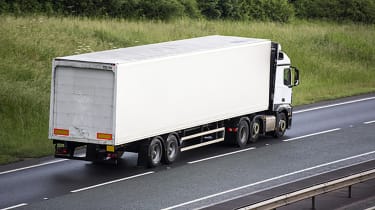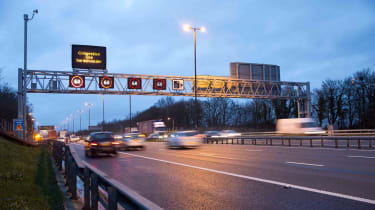Due to a change in the law in 2018, learner drivers are now permitted to drive on motorways in England, Scotland and Wales. This change was brought in to allow learner drivers to legally boost their experience and understanding of how to drive on Britain’s motorways before taking their driving test.
The latest rules mean learners in a dual-control car with L-plates can practise driving on motorways, provided they’re under the supervision of an approved driving instructor.
Motorway driving is not assessed in the driving test, however taking motorway lessons will allow a learner to gain this added experience in a safe and controlled manner before acquiring their licence.
Family members, friends, or acquaintances are not permitted to give motorway driving lessons, as the rules require a qualified instructor to be present. Learner motorcyclists and those who hold a Compulsory Basic Training (CBT) licence are still not allowed on motorways.
The change of rules was brought in to give learners experience of leaving and joining motorways and high-speed driving, as well as helping learners get used to motorway-specific signs, and understand what to do if they break down – a skill that has changed somewhat since the advent of smart motorways.
Safety chiefs from the DVSA announced the changes in the summer of 2017, and their decision followed broad support in a public consultation on the matter.
Motorway learners: top tips
While this is a positive move to help boost driver education, it could still be an intimidating experience for a new driver, though. The team at Auto Express has many collective years of experience driving on all kinds of roads, so who better to give you tips on motorway driving?
Motorways can be an intimidating place for any driver, whether you’ve just passed your test or not. The combination of high speeds, fast-moving traffic, large lorries plus multiple lanes and slip roads can cause confusion and panic if you’re not prepared. However, statistically motorways are the safest roads in the UK, because there are no pedestrians or cyclists, traffic is usually contained within the direction of travel and there is more space to use in the event of something going wrong.
Like driving on regular roads, driving on motorways requires concentration and forward planning. It’s important to be aware of your surroundings, so make sure that your windows are clear and mirrors are positioned correctly so that you can see what is going on around you – this is especially true of the nearside (left side) of your car, as it’s not a side of the car that you may normally focus on when driving on a regular road with two-way traffic.
Assuming you know how to use roundabouts and traffic-light controlled junctions, your first challenge will be to join a motorway. You’ll know when you are about to join one because the road signs will feature white writing on a blue background, with the M-designated road number written on them.
Joining the motorway
Unlike conventional junctions, where you must slow down as you approach them, the motorway slip road is designed to allow you to get up to speed before joining the main carriageway. As a rule of thumb, you should attempt to get to about 60-70mph by the time you’re at the end of the slip road so that you’re driving at a similar speed to motorway traffic. At this time you should also be aware of traffic that is already on the motorway, and you should adjust your speed so that you merge smoothly with traffic.
Use your mirrors and look over your shoulder to ensure that you are joining the motorway where there’s a space. Some cars feature a blind spot warning system that flashes lights in the wing mirrors to warn you of traffic that you are closing in on, but it’s always still worthwhile looking over your right shoulder as a final check.
Also, read the road signs. On some multi-lane motorways, the slip roads that you use to join the motorway can sometimes continue as an extra running lane. These will be indicated by arrow signs that show if the slip road joins the existing lanes and runs alongside them.
Once you are ready to join the motorway, make sure you use your indicator to inform other cars of your intention and then merge when you have the space to safely do so. It can be incredibly dangerous to slow down or stop on a slip road. Although motorway users have the right of way over those using the slip road, you must plan ahead so that you can merge without causing an obstruction to either.
Section 259 of the Highway Code states that you must do the following when on a slip road:
- Give priority to traffic already on the motorway.
- Check the traffic on the motorway and match your speed to fit safely into the traffic flow in the left-hand lane.
- Not cross solid white lines that separate lanes or use the hard shoulder.
- Stay on the slip road if it continues as an extra lane on the motorway.
- Remain in the left-hand lane long enough to adjust to the speed of traffic before considering overtaking.
Using the motorway
Once you’re on the motorway, the Highway Code states that you must keep left unless overtaking. This is something that learner drivers will hopefully be taught and have drilled into them. Doing this helps to reduce the number of ‘lane hoggers’ who can cause delays due to their blocking of faster moving vehicles.
If traffic is light, then you must move back to the left once you have overtaken another motorway user. However, as always, look ahead, and if there are a number of vehicles in the left-hand lane that you are going to overtake in quick succession, then you can stay in the lane you are in – if you are doing a marginally higher speed than a car you’re going to pass 1/4 of a mile up the road, then you should move back to the left.
If you encounter somebody who is going slower than you that hasn’t moved across to the left, it could be tempting to pass them on the inside. However, this is known as undertaking and is against the law (unless you’re queuing in slow-moving traffic). The best way to deal with this situation is to move across to overtake normally, and then move back across to the left as soon as possible, but without cutting anybody up.
Use your indicators whenever you are changing lanes when there is other traffic around. It helps other drivers know what you are doing, and can help them anticipate your actions and adjust their own driving in response.
Motorway hard shoulders
All standard motorways in the UK have a hard shoulder, which is designed to allow access to incidents and accidents for emergency services when the main carriageway is jammed with traffic. You must never drive on the hard shoulder unless indicated by a traffic officer, police officer or overhead gantry signs. The only reason you can legally stop on the hard shoulder is in an emergency – such as a breakdown.
The exception to this are smart motorways which sometimes allow you to drive on the hard shoulder in busy conditions. Signs on the overhead gantries tell you which lane you can drive in at any time and there are emergency refuge areas to use if you have a problem
Lorries and HGVs on motorways
HGVs can be a cause of intimidation for inexperienced road users. It’s worth noting that lorries have a lower speed limit than cars and most are electronically limited, too, so if you stick to the 70mph speed limit, it is unlikely that you will never be passed by a lorry. If you do end up being slower than a lorry and one ends up overtaking you, it’s best to cooperate with the HGV that is trying to pass you.
Slow gently so that it takes less time for the lorry to pass and get away from you. Once they have passed, safely build up speed again.

If you are approaching a convoy of lorries and one is indicating that they want to pull out to overtake another lorry, try to be courteous and co-operate with them, because the momentum built by an HGV is difficult to regain once it’s lost. A double flash of your headlights can let them know that you are willing to let them out, and if you have another overtaking lane to your right, check your mirrors to see if it’s clear of upcoming traffic and pull out to give the lorry even more space.
One thing to note is that HGVs, coaches and buses are not allowed to use the outermost overtaking lane. So if there’s a queue of HGVs in the lane next to it, none should pull out into the outside lane.
Leaving the motorway
Junction signs usually begin a mile ahead of the junction, although on some busier motorways these signs can start 2-3 miles ahead. If you’re looking at the junction signs, you may also see a small black square in the bottom corner of the sign with a number in it. This is the junction number, and corresponds with the information you’ll find on road maps, your sat-nav screen, and in traffic announcements on the radio.
If you are leaving the motorway, the advance warning of your junction should be enough notice to get across to the left-hand lane safely. Again the slip road is designed to help you slow to conventional road speeds, so there is no need to slow down on the motorway before you peel off – braking on the motorway can be dangerous and cause a concertina effect with drivers behind you braking in response to your actions.
One thing to be aware of is that the left-hand lane of the motorway can sometimes turn into a slip road. However, if you are aware of what is going on ahead of you by reading the road signs, you will get plenty of warning that the lane you are using is changing into a slip road.
Once you’ve passed your test, be sure to get off to the best start with our list of the best first cars for new drivers…

